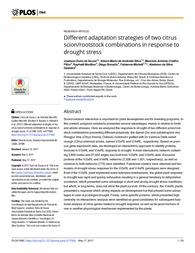Different adaptation strategies of two citrus scion/rootstock Combinations in response to drought stress.
Different adaptation strategies of two citrus scion/rootstock Combinations in response to drought stress.
Author(s): SOUZA, J. D. de; SILVA, E. M. de A.; COELHO FILHO, M. A.; MORILLON, R.; BONATTO, D.; MICHELI, F.; GESTEIRA, A. da S.
Summary: Scion/rootstock interaction is important for plant development and for breeding programs. In this context, polyploid rootstocks presented several advantages, mainly in relation to biotic and abiotic stresses. Here we analyzed the response to drought of two different scion/rootstock combinations presenting different polyploidy: the diploid (2x) and autotetraploid (4x) Rangpur lime (Citrus limonia, Osbeck) rootstocks grafted with 2x Valencia Delta sweet orange (Citrus sinensis) scions, named V/2xRL and V/4xRL, respectively. Based on previous gene expression data, we developed an interactomic approach to identify proteins involved in V/2xRL and V/4xRL response to drought. A main interactomic network containing 3,830 nodes and 97,652 edges was built from V/2xRL and V/4xRL data. Exclusive proteins of the V/2xRL and V/4xRL networks (2,056 and 1,001, respectively), as well as common to both networks (773) were identified. Functional clusters were obtained and two models of drought stress response for the V/2xRL and V/4xRL genotypes were designed. Even if the V/2xRL plant implement some tolerance mechanisms, the global plant response to drought was rapid and quickly exhaustive resulting in a general tendency to dehydration avoidance, which presented some advantage in short and strong drought stress conditions, but which, in long terms, does not allow the plant survival. At the contrary, the V/4xRL plants presented a response which strong impacts on development but that present some advantages in case of prolonged drought. Finally, some specific proteins, which presented high centrality on interactomic analysis were identified as good candidates for subsequent functional analysis of citrus genes related to drought response, as well as be good markers of one or another physiological mechanism implemented by the plants.
Publication year: 2017
Types of publication: Journal article
Unit: Embrapa Cassava & Fruits
Keywords: Citrus, Fruta Cítrica
Observation
Some of Embrapa's publications are published as ePub files. To read them, use or download one of the following free software options to your computer or mobile device. Android: Google Play Books; IOS: iBooks; Windows and Linux: Calibre.
Access other publications
Access the Agricultural Research Database (BDPA) to consult Embrapa's full library collection and records.
Visit Embrapa Bookstore to purchase books and other publications sold by Embrapa.

